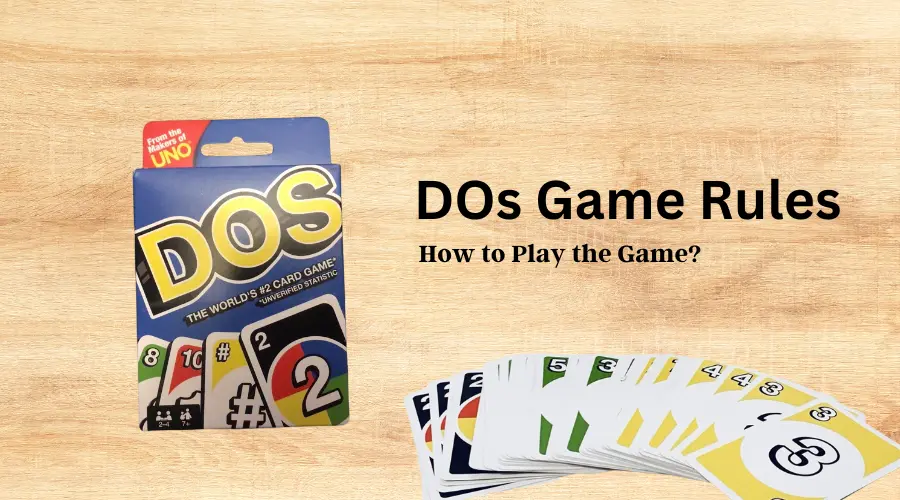Uno game has a great sequel made by Mattel known as the Dos card game.
In this post, I will cover the entire Dos Game rules and how to play the game step by step.

Let’s get started!
What is Dos Card Game?
The term Dos means two. Uno means one, and Dos means two. Dos is a sequel for Uno. It was the same home company Mattel that introduced Uno and Dos.
The company introduced dos in 2018. The game is quite exciting and is the most interesting card game that you will ever come across. Uno and Dos are slightly similar, but both games have several differences.
To play Dos, you need 2-4 players. This is less than Uno. To play Uno, you need more players. The card composition of Dos is 108.
Out of this, 96 cards are numbered and colored. They are either Red, Blue, Yellow, or Green. There are 12 wild cards in the game of Dos. There are three cards of each number 1,3,4,5 and two cards of 6,7,8,9, and 10. The wild cards for each color are 2 in number.
Apart from numbered cards, Dos also has unique wild cards. These wild cards are not the same as in Uno,
The objective of the Game
The game’s primary objective is just like Uno – discard all the cards at hand before any other player. Unlike Uno, the cards can be discarded by matching them with the cards at the center by their number.
Matching the number is more important than matching colors in the game of Dos. Colors don’t play a significant role in this game. The only benefit you can gain from matching colors is a color-matching bonus point. The first player who reaches the mark of 200 points is the winner of the game.
Things to Know Before Playing Dos Card Game
How many cards are in the DOs?
The game of Dos has 108 games
Number of Players that Can play Dos
2-4 players can play the game of Dos
What is the age limit for playing Dos?
Anyone above the game of 7 can easily participate and play.
How to Play DOs?
Setting Up the DOs card Game
To decide the starting player for the game, cards are drawn. Initially, all the players draw a card randomly from the deck.
The player who pulls the card with the highest number becomes the game’s dealer. While this process, if any player draws the wild card, it will be counted as 0.
After the game’s dealer is decided, the cards are shuffled to ensure they are mixed up properly. After that, the dealer will hand over 7 cards to each player.
The leftover cards are placed in the center of the table and form the draw deck. Now, each player has 7 cards they can look at and a draw pile at the center to play the game.
The game also needs players to flip 2 cards from the top of the deck and place them in a face-up position next to the stack.
When the turn comes, each player will play the cards from their hands to the cards in the center row if there is a color or a number match.
There should be space beside the card deck to form the discard pile
GamePlay
Each player will get their turn to play. The game starts with the player right to the left of the dealer.
When the player gets a turn, they can play the cards in their hand by matching them with the cards in the center row.
If none of the cards from your hand matches the ones in the center row, be it in color or number, players must take up a new card to form a match and play it.
Even if the player can’t play after taking up a card, put it in the face-up position next to the center-row cards.
The player must discard stacks only if they have played the cards from their collection during their turn. The least number of cards in the center row should be 2, and there can be more.
Matching the cards is one of the primary objectives of the Dos game. There are usually two types of card matches that occur in the game.
The first is a single match. In this match type, the players will play 1 single card from their hand and match it with one card from the center row with the same number.
Here the color of the cards does not matter. In color matches, you can always get a color-match bonus.
The other type of match is a double match. In this one, players have to play 2 cards that will add up to the card number of any card in the center row. In this case, as well, matching the color is optional.
Single color match and double color match are two types of popular card matches in Dos. in single color match, if you play the card
Ending the Game
The ending is quite similar to that of Uno. You just have to scream out aloud “Dos” when you are near closing out the game.
If another player catches you close to the ending, and you haven’t said Dos aloud, you will surely lose the game.
If it happens, the player will have to draw 2 cards extra from the deck. The turn will keep on going clockwise.
Scoring in Dos Card Game
Any card with numbers 1 or 3 – 10 (except 2) is worth of point and equal to its face value. Any card with # is worth 20 points. The wild cards in Dos are worth 40 points each.
Strategies to Play and Win Dos Game
The game of Dos is lovely as long as you can ace the strategies. The best strategy possible is to emphasize card numbers because the colors don’t make any difference in this case.
The target should be to win more than 200 points at the end of a Dos round. If a player can do this, they can win the game immediately.
How is DOS different from UNO?
The cards of Dos and Uno are different from each other. Moreover, less number of players are needed for Dos. Color matching is essential in Uno, whereas it hardly matters for Dos. The game rules for wild cards are also unique to both games.
Is DOS a good game?
Yes. It is a great game. You can enjoy it with your friends and family.
Conclusion
Let’s conclude the post on Dos rules and how to play the game!
I hope after reading this post, you are comfortable with the rules and gameplay details.
Thanks for reading!
References:
- Dos at Mattel Shop: https://shop.mattel.com/products/dos-frm36
- Dos Instruction Manual: https://content.syndigo.com/asset/2a838488-243b-433b-8aff-19d1ce319758/original.pdf
What’s Next? Check these UNO Versions!
Explore Other Versions of the popular card Game UNO:
